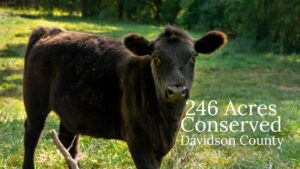
By: Crystal Cockman
![IMG_1216[2]](http://landtrustcnc.org/wp-content/uploads/2015/01/IMG_12162-300x168.jpg)
Grouse live mostly in wooded areas, but they like cover and feeling secure, so are typically found in areas with younger forests kept open by disturbance, including cutting or fire. Walking through the areas we were hunting in West Virginia was a challenge to say the least, which included tangles of down trees and limbs, briar thickets, and areas of dense brush, which made walking tough. We all came out looking a little like we got in a fight with a wild cat with all the scratches from briars and thorns, but we enjoyed the challenge as part of the experience. For our efforts, we did have six flushes total with four different birds, and we all got to shoot at a bird. And though we didn’t come home with one, we had a fantastic time. One of our buddies had bird dogs also and though we ended up flushing the birds just walking through this time, it’s always a fun experience to hunt with dogs and watch them work, too.
The Ruffed grouse (Bonasa umbellus) is North America’s most widely distributed game bird. It is found in the Eastern United States and Canada, up into Alaska, with its range also extending down in the Rockies in the west. In North Carolina they are found in the west in the Appalachian Mountains, and extend down into northern Georgia and northeastern Alabama. At one point they went as far south as Arkansas. There are 14 subspecies of ruffed grouse. In the major part of its range, grouse exists in areas where regular snowfall occurs from November to April. They love snow and thrive in it, unlike some other game birds such as quail, pheasant and turkey.
Ruffed grouse are a striking bird. They have a crest and a long fan-shaped tail, with patterns of dark bars and spots of red, brown, gray and white. The name “ruffed” comes from the long, shiny black feathers on the neck. When defending their territory or displaying to a female, they fan their tail and extend these neck feathers into a ruff. In terms of size, they are larger than pigeons, with weights ranging from 17 to 25 ounces. In North Carolina, they are found only in the mountain region, and grouse season here is from October 13th to February 28th. There is a daily limit of 3, and a season limit of 30.
The males are territorial and defend their area of up to 10 acres of woodland. The male exhibits an interesting defensive behavior display by beating their wings to produce a deep drumming noise. They typically stand on a log known as a “drumming log” when they do the display, elevated about a foot off the ground, but the sound comes from their wings beating against the air, not the log. The same display is used more frequently for courtship in springtime.
If you don’t mind traveling through some tough thicket areas, and enjoy the challenge of finding and shooting a flying bird, grouse hunting may be for you. It’s an exciting event to hear the bird flush with its wings flapping, and your buddy shout “bird!” across the woods from you, as you prepare and hope for the grouse to fly your way. Whether you manage to secure a bird or not, a fun hunt in a scenic place is worth the effort by itself. The beautiful scenery as we climbed up into the white pine forests was a great experience, and we came home already planning for our next adventure.